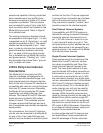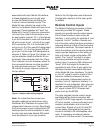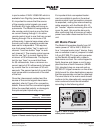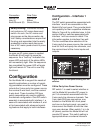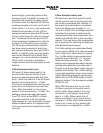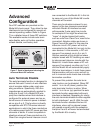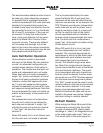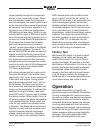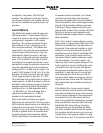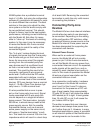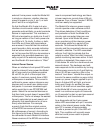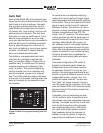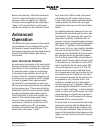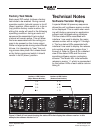
Issue 2, September 2007 Model 46 User Guide
Page 20 Studio Technologies, Inc.
longer passing through this component
and on to the 4-wire audio output. When-
ever this situation arose the component
was not damaged, but restoring the flow of
audio required either a power down/power
up sequence, an auto null operation, or a
change to one of the level configuration
DIP switches to take place. While it is very
unlikely that this type of ESD event would
occur during normal field operation it is of
concern for critical Model 46 applications.
To minimize the chance that the audio
path could experience this problem a
“refresh” routine was added to the Model
46’s operating software (“firmware”). To
ensure that the ESD-sensitive component
always remains functioning correctly the
software resends its operating instructions
four times each second. With this imple-
mentation the worst case scenario would
result in an audio loss of 250 milliseconds
or less in the event of an extreme ESD
“hit” being experienced.
But nothing comes without a price and in
this case the refresh routine adds a very
slight audio “tick” to the 4-wire output and
2-wire party-line signals. During typical
applications these refresh “ticks” will not
be noticeable. But there may be situa-
tions where any added audio artifact may
simply not be acceptable. To address this
possible, but highly unlikely, case back-
panel DIP switch 3 can be used to disable
the refresh routine. When switch 3 is in its
off (down) position the Model 46 operates
in its standard fashion. When switch 3 is
in its on (up) position the refresh routine
is disabled. The Model 46 will continue to
function normally with the exception that
the four-times-per-second component
refresh routine will not occur. Goodbye
“click” but hello to the possibility that an
ESD-induced audio path problem could
occur. A good “rule of thumb” is that if a
Model 46 is mounted in an equipment rack
with a known-good ground connection,
disabling refresh shouldn’t pose any risk
to reliable operation. But if a unit is mount-
ed in a portable rack, or used loose as a
single device, refresh should always remain
enabled. The reasoning is quite simple:
the latter condition is much more likely to
allow an ESD “hit” to dissipate into the
Model 46’s enclosure, while a substantial
rack enclosure will offer a low-impedance
path for ESD energy to dissipate into.
Factory Test
Back-panel DIP switch 4 is used to select
between normal mode and factory test
mode. When switch 4 is in its off (down)
position the Model 46 operates in its stan-
dard fashion. When switch 4 is in its on (up)
position the factory test mode is selected.
As expected, when the Model 46 is de-
ployed in the field switch 4 should remain
in its off (down) position. No damage to
the Model 46 or connected equipment will
occur when factory test mode is active.
Operation
Technician intervention is typically not
required during normal Model 46 operation.
The unit is designed for continuous opera-
tion with no routine maintenance necessary.
Activating the auto null functions may be
warranted should connected user devices
or wiring associated with the 2-wire party-
line intercom be changed. Upon power-up
the Model 46 will go through a short initial-
ization sequence before normal operation
will begin. The power and status LEDs
will each light sequentially and, upon



